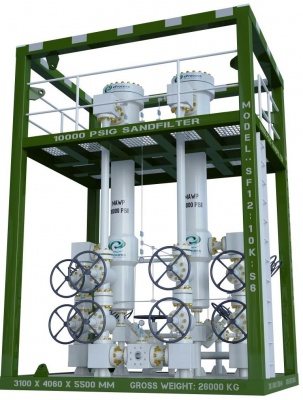Wellhead Screen-Filter – Purpose, Design, and Comparison to Multiphase Desander (B-FSM-101)

Purpose: The Wellhead Screen-Filter, commonly called a Dual-Pot Sand Filter, is a service tool used to capture coarse solids from well flow during flow-back and cleanup.
Definition: A unit process device consisting of a batch, constant-pressure, surface (cake) filter with a cylindrical rigid metal screen medium, and used to clarify coarse (>150 µm) solids from multiphase well flow.
Comparison to Multiphase Desander:
- The Wellhead Screen-Filter and Wellhead Desander are both used as a service tool during well flow-back and clean-up operations
- The WSF is not used in permanent production operations. The multiphase desander in Wellhead or Wellstream version, are commonly installed as a permanent part of facilities to deal with long-term sand production.
- Both devices work in multiphase or liquid-only flow.
- The WSF has infinite turndown as the separation mechanism is not pressure drop dependent. The multiphase desander has a finite (~5:1 turndown) based on the flow-pressure relationship.
- The WSF separate solids effectively down to 100-150 microns, while the multiphase desander can separate down to 15-20 microns.
- The WSF has a 50-60 liter solids hold-up volume before backflush, while the multiphase desander has 150-300 liter solids accumulation volume.
- The WSF requires 2 x 100% layout to allow flushing of one unit while the other is in operation. The multiphase desander stays online at all times during operation, even during solids flushing.
- For the multiphase desander fluid viscosity has a directly proportional relationship with separation size, while the WSF maintains separation performance at all fluid viscosities. However, both units show increase pressure drop with increasing viscosity.
References:
- Rawlins, C.H., “Separating Solids First – Design and Operation of the Multiphase Desander”, paper 185658-MS presented at the SPE Western Regional Meeting, Bakersfield, CA, 23-27 April, 2017. https://doi.org/10.2118/185658-MS
Next week I will cover general design and operation of the WSF.
